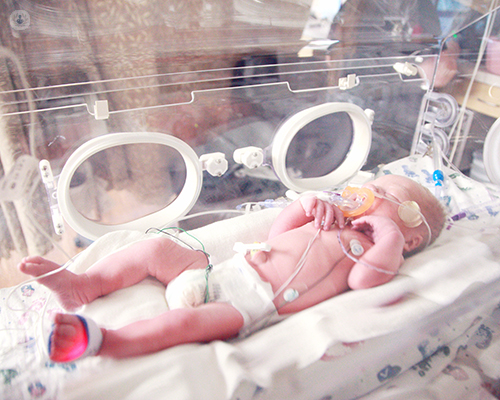Neonatal respiratory distress syndrome
Dr Ramnik Mathur - Paediatrics
Created on: 11-13-2012
Updated on: 09-21-2023
Edited by: Sophie Kennedy
What is neonatal respiratory distress syndrome?
Neonatal respiratory distress syndrome, also referred to as neonatal RDS or infant respiratory distress syndrome, is when a newborn baby’s lungs are not fully developed causing him or her to have difficulty breathing normally. It usually occurs in premature babies because the lungs haven’t had time to fully develop.

What causes neonatal respiratory distress syndrome?
The lungs require a substance called surfactant to expand and contract and also to keep the air sacs in the lungs open. When a baby is born prematurely, they very often lack enough surfactant which causes lung problems and difficulties breathing. Without enough surfactant, the lungs can collapse and the baby has to work hard in order to breathe.
Generally, the earlier a premature baby is born, the higher the chance of neonatal RDS developing. Neonatal RDS can also be due to a genetic problem.
Some factors can increase the likelihood of a baby having this condition, such as:
- Maternal diabetes
- Caesarean delivery before the baby is full-term
- Problems during delivery which reduces blood flow to the baby
- Rapid labour
- A brother or sister who suffered neonatal RDS
What are the complications associated with neonatal RDS?
Neonatal respiratory distress syndrome may get worse for 2 to 4 days after birth and in serious cases, it can be fatal if not treated properly. If the baby doesn’t receive enough oxygen it can cause damage to the brain and the vital organs.
Complications may include:
- Collapsed lung
- Blood clots
- Blood infections
- Bleeding on the brain
- Kidney failure
- Bleeding in or around the lungs
- Build-up of air in the sac around the heart and/or lungs
- Blindness
Every baby is different and the severity of the condition is also different in every case. It’s important to note that these are only possible complications and may not even occur.
What are the symptoms?
Most of the time, a baby will begin showing signs and symptoms immediately after birth. Occasionally, symptoms can take up to 24 hours to develop so keeping a close eye on symptoms is important. These include:
- Bluish colour of the skin
- Rapid or shallow breathing
- Grunting sounds while breathing
- Nasal flaring
- Brief stop in breathing
- Decreased urine output
How is it diagnosed?
Various medical tests may be used to assess breathing difficulties in babies. These include a blood gas analysis, which shows excess acid in the body fluids and low oxygen levels, a chest x-ray and lab tests, which help eliminate infections that could worsen breathing problems.
What is the treatment?
Firstly, the baby is admitted immediately to a neonatal intensive care unit. Whilst there, the baby can be given one or more of the following treatments:
Surfactant replacement therapy
This type of therapy gives the baby the surfactant they need in the lungs. It is administered through a tube to make sure it goes directly into the lungs. Usually, the baby is then connected to a ventilator to offer extra breathing support.
Nasal continuous positive airway pressure (NCPAP) machine or a ventilator
The baby may need breathing support which a ventilator can provide. This treatment consists of placing a tube down the windpipe and breathes for the baby. An NCPAP is less invasive and provides oxygen through the nostrils via a mask.
Oxygen therapy
This treatment involves delivering oxygen to the baby’s organs in the body via the lungs.
